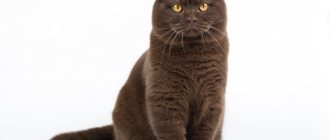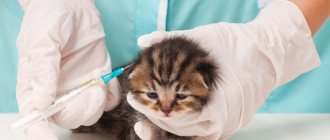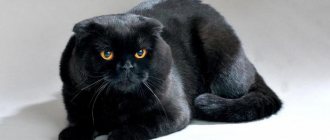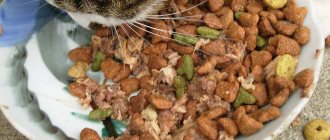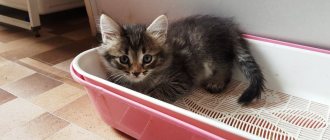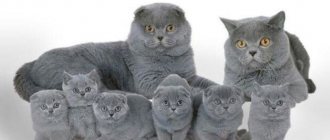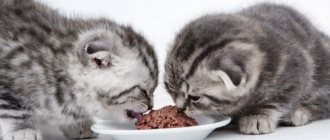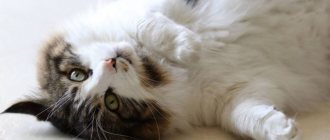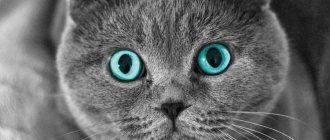Now let's define the terms. In fact, the term " sterilization" is not always correct. Sterilization (oophorectomy) is the removal of only the ovaries, which has hardly been practiced in recent years. Castration (ovariohysterectomy) is the removal of the ovaries and uterus. But nevertheless, even many veterinarians use the term “sterilization”, meaning castration, because. clients are accustomed to this formulation. In this article, we also use these two words as synonyms for convenience.
There is another type of sterilization - tubal ligation (tubal occlusion) or removal of the uterus while preserving the ovaries (hysterectomy). After this procedure, the cat remains in heat, that is, she continues to attract males, but cannot conceive. With this approach, the cat continues to have empty heats, which will most likely result in an inflammatory or cancerous disease sooner or later. But nevertheless, occasionally owners perform this particular operation. Why? It is needed if there is a cat and a breeding cat living in the house, which does not mate every day to produce high-quality offspring, but there is a need for sexual intercourse. Then the cat living next to him, whose pregnancy is unwanted, has her tubes tied, as a result of which, during the breaks between participation in breeding matings, the cat can have sex with her without any consequences, and thus keeps himself in shape. In this case, the owners act in the interests of the cat, but to the detriment of the interests of the cat. In our opinion, this is inhumane, but here we are talking not about humanity, but about business.
In all other cases, veterinarians advise performing either oophorectomy (removal of the ovaries) or immediate ovariohysterectomy (removal of the ovaries and uterus). Many veterinary clinics have left only the second method in their price lists, because it is preferable: if only the ovaries are removed, the risk of developing cancer and inflammatory diseases of the uterus remains. Then the operation has to be done again, but with a greater likelihood of a negative outcome.
All of the above types of operations can be performed using two methods, which differ in the method of penetration into the abdominal cavity.
Laparoscopy is a surgical operation under general anesthesia, in which penetration into the abdominal cavity occurs through tiny incisions (usually 2-3 with a diameter of 3 to 10 mm each), introducing a special instrument with a camera into the incisions, which displays an image on the screen and allows operation without visual access of the doctor to the insides. This operation is considered minimally invasive, that is, low-traumatic, after it minimal treatment of the wound is required, a short postoperative period, there is no need to wear a blanket, and the sutures are made from self-absorbing threads. If you click on the photo, additional illustrations will open in a separate window.
Traditional abdominal surgery (laparotomy) is an operation with full visual access of the surgeon to all the internal organs of the cat, without any cameras or screens. It is more traumatic, as it involves one incision from 2 to 10 cm. After it, a long rehabilitation period (10-14 days) is required with stitches and wearing a blanket. This is the type of operation that is most often practiced and is considered a classic method. In contrast, laparoscopy is a newfangled, expensive method. If you click on the photo, additional illustrations will open in a separate window.
If you're not afraid of technical details, you can watch a training video for surgeons on how to perform surgery on a cat. It contains a lot of details that are unnecessary for the average person, but you will become familiar with the process in great detail.
Laparoscopy for cats began to be performed relatively recently, so this operation is not available in all clinics. And it costs several times more. In addition, it is not certain that your veterinarian has the necessary experience. Therefore, in conditions of limited choice in small towns, it is always better to opt for the operation that specific doctors in the veterinary clinic can perform masterfully.
Features of sterilization of Scottish breeds
Sterilization and castration of representatives of Scottish breeds has some subtleties. It is advisable to carry out such procedures after the animal reaches puberty, but before the first mating. This will reduce the risk of adverse effects associated with performing the necessary manipulations and anesthesia. Representatives of Scottish cat breeds are distinguished by late maturation.
If sterilization was carried out after mating, even removal of the uterus and ovaries does not always eliminate the signs of heat. Removal of the ovaries and uterus in this case does not stop the activity of the pituitary gland, so sexual desire can persist due to a compensatory increase in the production of sex hormones at the physiologically programmed time of estrus.
In this case, sterilization surgery allows you to avoid the appearance of offspring, but will not save you from the obsessive behavior of the animal. The situation is similar for cats of Scottish breeds. Males should be castrated before their first mating.
What vaccinations are given to kittens, cost
Small, helpless kittens receive the first antibodies that increase immunity along with the mother's cat's milk. After weaning, instead of colostrum, the baby needs additional protection of the body from viruses and bacteria. At the age of 8-10 weeks, vaccinations are required for Scottish kittens. Before the first vaccinations are carried out, the kitten is prepared and the body is prevented from worms.
Depending on the conditions of detention and lifestyle, the first vaccination for a Scot contains:
- a vaccine against herpesvirus, calicivirus, panleukopenia and rabies, even if the animal leads a permanent home lifestyle;
- They also vaccinate against viral leukemia and chlamydia if the kitten lives in a private house, in a country house and leaves the house where it has likely contact with other animals;
Vaccinations for fold-eared kittens, as well as straight-eared Scots, are performed in accordance with the following scheme:
- At 2 months, the full range of vaccinations with the exception of the rabies vaccine;
- At 3 months, revaccination is carried out with the same complex of drugs with the addition of rabies vaccine.
- Every year and beyond, as the child grows, the entire vaccination package is repeated, including the anti-rabies drug.
The cost of vaccination depends on the price of the drug and factors of the procedure in different regions of the country and consists of:
- from the cost of the most common complex of drugs: Purevax RCPCh + Rabizin + Nobivac Rabies;
- prices for issuing a veterinary passport;
- payment for the work of a veterinarian;
- payment for calling a doctor to your home.
Adults (what vaccinations are given to adults + cost)
Vaccinations for adult cats and Scottish cats have the following advantages:
- they support the immunity of animals to environmental living conditions.
- Vaccinated pets develop a persistent, throughout the year, resistance to serious diseases;
- The vaccinated animal is protected itself and the owner is guaranteed protection, for example, from rabies;
- The occurrence of some infectious processes in a mild form
- When walking in nature and interacting with other animals, the risk of your pet contracting an infection is reduced to a minimum.
Throughout life, the vaccination procedure is repeated annually, preferably in the same month of the year. They make sure that the animal is dewormed on time, is healthy, and that the cat is not pregnant or nursing cubs.
The basic composition and cost are similar to vaccination for kittens, depending on the region and other factors.
Types of sterilization
There are several options for operations used to sterilize Scottish cats. In addition, several procedures have been developed to make castrating cats as painless as possible for him. Nowadays, both surgical and chemical methods are actively used in veterinary practice.
Classical sterilization is quite traumatic for a cat. It is performed through a wide incision along the linea alba or along the side. The second option is less traumatic, but often does not allow sufficient access to completely remove the reproductive organs.
Tubal occlusion procedures are often used to prevent pregnancy in cats. This manipulation involves a laparoscopic intervention in which ligation of the fallopian tubes is performed. Since the organs of the reproductive system are not removed in this case, the animal tolerates such intervention more easily.
Laparoscopic sterilization is often performed. This procedure involves gaining access to the organs through a small incision not exceeding 2 cm. After this, a special disinfected hook is inserted into the wound, with the help of which the ovary and the ligament supporting it are hooked. After this, a ligature is applied and the ovary is removed. The entire uterus can be removed in the same way.
Endoscopic sterilization is an expensive and effective method of surgery. During such a surgical intervention, all manipulations are carried out with special instruments, under the control of an endoscope equipped with a light source and a camera. Access is obtained through small punctures in the abdominal cavity.
In addition, the procedure of oophorectomy is often used. It involves removing not only the ovaries, but also the uterus. Such a procedure can be carried out both according to indications and as planned. Since a long incision is made to perform the manipulations, the cat requires long-term rehabilitation after an ovariectomy.
If radical sterilization is undesirable, a chemical method can be used. This type of sterilization involves sewing a special implant under the skin, thanks to which a drug that suppresses the animal’s sexual activity enters the animal’s bloodstream. The effect of such an implant is limited to 3 years.
Early sterilization
To prevent the appearance of sexual desire, the animal is often neutered early; in this case, the kitten may develop health problems in the future. If the cat was spayed between 6 and 8 months of age, in most cases there will be no postoperative problems, since the organs are already well developed during this period. When carrying out early sterilization, faster healing of wound surfaces is observed with minimal risk of complications.
Cats that survive early neutering develop a more powerful musculoskeletal system. At the same time, in the future, Scottish cats who have undergone the procedure often experience hormonal imbalances. Most often, after early castration, animals experience inappropriate behavioral reactions due to increased activity of the pituitary gland.
Early sterilization can also have delayed consequences. Often, cats that have undergone a similar procedure before puberty develop endocrine diseases at 5-7 years of age. In addition, kidney function may deteriorate.
Postoperative care rules
Care of the wound surface in cats is not required. However, you need to ensure that your pet does not lick the wound area. If sterilization in cats was carried out laparotomically, then the sutures need to be treated from the second day. For this, antiseptic solutions and ointments are used to improve regeneration.
The main negative consequence for a pet after castration is obesity. Therefore, sooner or later the question arises of what to feed a neutered Scottish cat:
- If the pet was on a natural diet, then it is necessary to review the diet. First of all, you need to determine your daily calorie intake. After castration, it is recommended to slightly reduce the portion. If previously the norm was calculated using the formula 80 kcal per 1 kg, then after castration the caloric intake decreases: 60–70 kcal per 1 kg. In addition, add more fiber to your diet in the form of vegetables, as well as boiled meat. Also eliminate milk from your diet.
- If the cat has been eating dry food, it is better to change it to a special product for neutered animals. Such foods have a balanced composition and are also aimed at preventing urolithiasis. For example, Vet Care Nutrition from Royal Canin (premium food) or Proplan food labeled Sterilized.
Sterilization of adult cats
Despite the fact that it is advisable to sterilize Scottish cats at a young age, mature animals are also seen by a veterinarian for this purpose. Adult cats are more difficult to tolerate such interventions, since any wound surfaces heal more slowly in them.
At the same time, carrying out manipulation allows not only to correct the behavior of the animal, but also to reduce the risk of developing dangerous complications, incl. cystic formations and some types of cancerous tumors. In addition, for older cats, labor is associated with a high risk of complications. In this case, timely castration can prevent death.
Care
Do not be alarmed when, after the procedure, the veterinarian gives you a half-asleep animal in an almost unconscious state. The pet can remain in this form for up to a day - this is the effect of anesthesia. It is better to leave a sleeping cat on her favorite bed, but always on the floor. Gradually, the cat will begin to come to its senses, at first its coordination of movements will be impaired, and if it wakes up on a hill, for example, on a window, it can fall to the floor and get injured. By the way, it is not recommended to feed animals before surgery.
A mandatory rule in the postoperative period is rest and warmth. Under no circumstances should you leave a newly sterilized cat on the balcony or terrace - this can even lead to death. Make sure that the animal does not lick the wound area. If sterilization was carried out with an intradermal suture, then the cat does not need a blanket. If it was an external suture, then a special blanket is put on the animal, and after about 10 days the owner will have to visit the veterinarian again to have the sutures removed.
After surgery, every owner is required to change the pet’s diet. For example, for cats it is recommended to reduce the daily portion. The menu should be supplemented with fiber and boiled meat. If the owner prefers to feed his pet with special food, then it should be premium and super-premium products. It is recommended to consult a veterinarian regarding nutritional issues for a specific animal. The doctor will not only recommend the products of the most suitable manufacturer, but will also individually calculate the daily food intake.
See below for information on cat sterilization.
Cons of the operation
Any surgical intervention in animals carries some risks. The most common postoperative complications include:
- peritonitis;
- suppuration of wounds;
- sepsis;
- deterioration of the cardiovascular system;
- pulmonary edema, etc.
These violations can cause death. To prevent the occurrence of postoperative complications, it is necessary to conduct a comprehensive examination of the animal in advance and assess its general health. In addition, approximately 5% of Scottish cats experience a temporary increase in sexual desire after complete removal of the uterus and ovaries. Increased anxiety of the animal can persist for 6 months.
Consequences
The consequences of a cat sterilization operation depend on how many months the procedure was performed. If the manipulation was performed before the onset of puberty, when the internal organs of the animal are not yet fully formed, the risk of further inflammatory diseases of the urinary tract and the formation of stones is increased.
It has been noted that Scottish Fold cats require a special diet. If fed improperly, animals quickly gain weight. Obesity in Scottish cats often causes problems with the cardiovascular and respiratory systems. These pathologies can negatively affect the life expectancy of the animal.
All information posted on the site is provided in accordance with the User Agreement and is not a direct instruction to action. We strongly recommend that before using any product, you must obtain a face-to-face consultation at an accredited veterinary clinic.
What happens after castration?
Next, we will look at some of the physical changes that occur after castration in Scottish cats.
Obvious.
First of all, one obvious change you will see in your cat after the spaying procedure is the absence of their testicles, which will be very noticeable to you, but something your cat won't understand!
Physical form.
A common myth is that neutered Scottish cats are prone to obesity. Only a change in physical activity after surgery can lead to slight weight gain.
An unneutered cat, especially if it goes outside, walks a lot, sometimes wandering during the day and walking many kilometers to find a mate or “patrol” its territory. Because this urge goes away after neutering, your cat likely won't be as hyperactive after surgery and will therefore need to eat less to maintain his condition.
Neutered Scottish cats may appear a little less lean as they simply won't be as active as cats who run around outside every day!
Head shape.
A mature, unspayed Scottish cat will often develop a fairly cool head by the time he is two or three years old, due to the levels of testosterone and other sex hormones that are produced in his testicles. Neutering Scottish males before the age of one year usually results in your cat's head and face not expanding to the extent it would have if they had not been neutered, however, if your cat is neutered as an adult, his head will already be larger. large, and the jaw is wide, and this is not canceled by the castration procedure.
Condition of the coat.
While most non-neutered cats are not very particular about their appearance and fur, neutered cats are more careful. If an unneutered cat spends most of his day patrolling his territory, looking for a female, then he, as a rule, is very busy with some other important matters for him and slightly neglects caring for his fur.
In Scottish cats, it is especially pronounced that without care, the coat acquires a slightly matte tint; the cat looks unkempt and shabby, especially if it goes away for several days without caring for or caring for its coat. But after castration, you may be pleasantly surprised to see that your cat has suddenly become very clean and careful about keeping his fur in good condition.
Smell.
Unneutered cats have a peculiarity; this manifests itself not only in the desire to mark, but also in the fact that the cat itself begins to stink a little. This is absolutely normal and even good for a cat in the wild, where he shows his higher position in the hierarchy. But in an apartment, few people are happy with this situation. Neutering Scottish cats helps get rid of this smell; after surgery, it goes away on its own within a few weeks.
Obvious.
Physical form.
Head shape.
Condition of the coat.
Smell.
